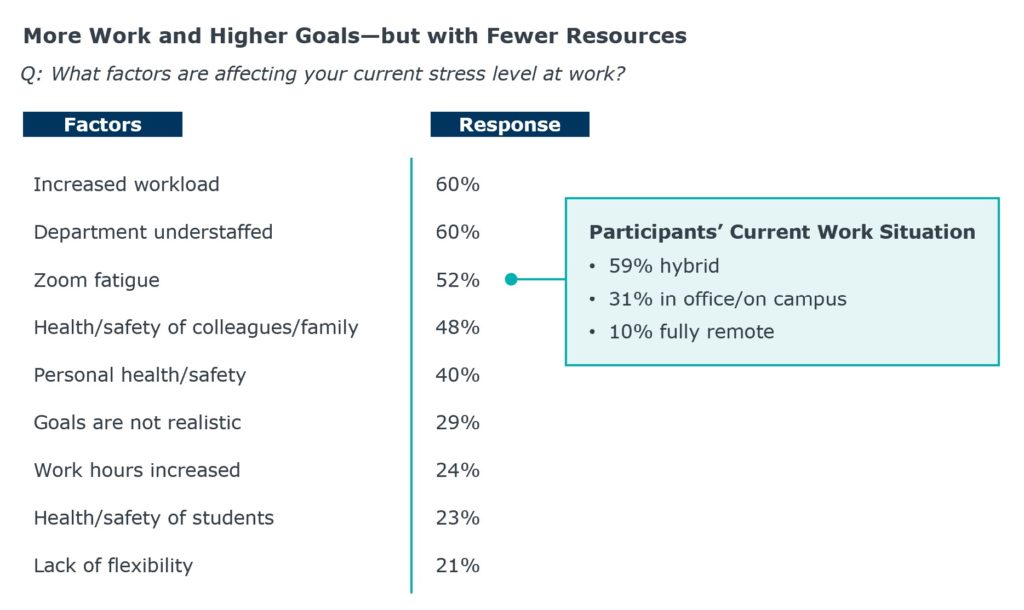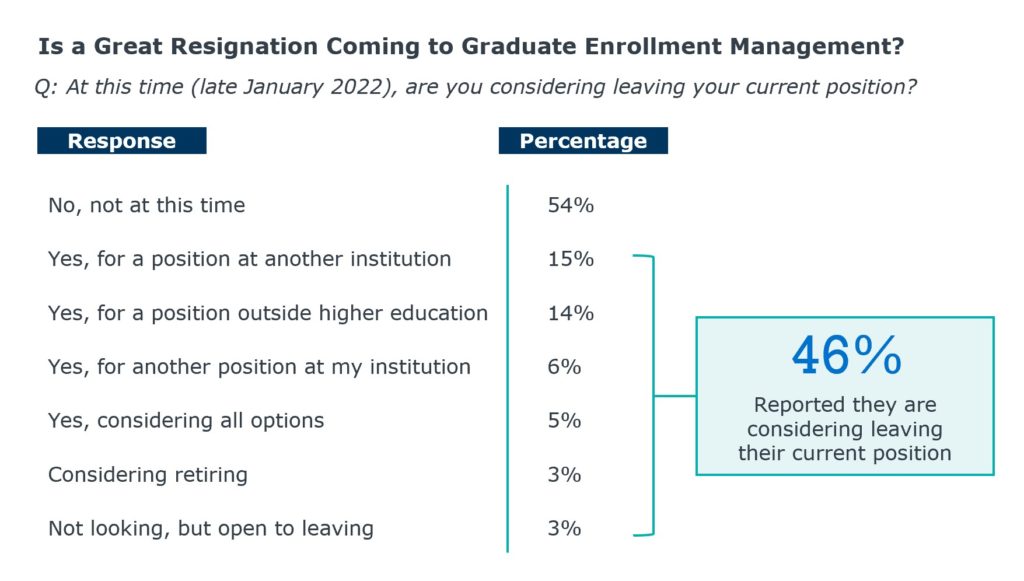Graduate enrollment leaders are burned out. Here’s why—and how you can help.
These are just a few of the sentiments graduate enrollment leaders shared in our recent survey about their mental health and wellness. Given the events of the last two-plus years—and the acute pressure graduate enrollment leaders face to generate revenue and offset undergrad enrollment shortfalls—it’s no surprise that survey respondents report heightened levels of stress. What is surprising: just how pervasive this stress has become. Half of the grad enrollment leaders we surveyed (in partnership with NAGAP) said they are “extremely” or “very” stressed at work.
-
49%
of survey respondents said they are “extremely” or “very” stressed at work.
Beyond the well-documented stressors that come from living and working through a global pandemic, what factors are driving the pressure graduate enrollment leaders face? And how might these stressors influence the future of graduate enrollment management?
EAB partnered with NAGAP to conduct eight “flash polls,” resulting in feedback from 1,216 graduate enrollment leaders representing 790 institutions. The research was conducted from fall 2020 through spring 2022. Here’s what our survey of 1,200+ practitioners tells us.
It’s not just COVID—increased workload and staff shortages are (partially) to blame
Although the pandemic somewhat waned after the first vaccine dose became broadly available, graduate enrollment leaders’ stress did not. Forty-three percent of respondents said they are experiencing more stress in 2022 than in 2021—suggesting that factors beyond the pandemic are contributing to their stress.
Graduate enrollment leaders we surveyed identified increased workload and department understaffing as the top factors affecting their stress levels. Respondents most often indicated their increased workload comes from unrealistic enrollment goals set by university leadership and the need to transition marketing and enrollment strategies to a virtual environment. Staffing shortages, due both to the Great Resignation and revolving door of staff out of office for COVID-related reasons, have added to their workload.
Since the pandemic, the economy has changed drastically. We can't hire new staff at the old hiring rates, and our current staff are all underpaid.
Survey Respondent
More than half of respondents also attributed some of their stress to Zoom fatigue. Survey respondents report back-to-back Zoom meetings leave little time for important independent work. At the time of our survey, 31% of respondents were working on-campus. Only 10% of respondents were working fully remote, and the remaining 59% were using a hybrid work model.
I would like to see more flexibility in remote work. It's been proven that staff are capable of working remotely, and it should be considered moving forward.
Survey Respondent

A staffing problem poised to become worse
At the time of our research, 61% of respondents had at least one unfilled position in their department. As you likely have experienced at your own institution, this is a pervasive problem across most university divisions. Overall, higher ed lost up to 11% of its workforce during the pandemic, based on our researchers’ analysis data from the Bureau of Labor Statistics.
While higher ed is on track to recover from this labor loss, 46% of our survey respondents indicate they are considering leaving their job. Of this group, 15% said they are considering a role at another institution, while 14% are interested in roles outside of higher ed all together. Only 6% of the respondents who are looking to leave their role are considering another position at their current institution.

A call for additional staff, flexibility, and recognition
Reading and analyzing these survey responses was, admittedly, disheartening for my team and me. And likely will be for many of the university leaders reading this post. But the enrollment leaders we surveyed also shared a few ways their institutions can better support their mental health and wellness and, ultimately, alleviate their stress.
Survey respondents identified “additional staff and filling vacant positions” as the best way their institution could alleviate work-related stress. Graduate enrollment leaders also said more flexibility (such as remote or hybrid options), better support and recognition from leadership, realistic goals, and better pay would meaningfully reduce their stress levels.
Here are a few ways university leadership can support graduate enrollment leaders, in their own words:
- “More transparency. More voice. More feeling like I’m being heard by decision makers.”
- “Additional staffing and more support for graduate education from campus leadership.”
- “More realistic enrollment goals and budget, both based on data.”
- “Hybrid work schedules.”
- “Prioritizing staff health and safety as much as that of students and faculty.”

More Blogs

4 questions domestic students will ask before applying to your graduate program

When Grad PLUS disappears: What 8,000+ grad students said about paying for school
